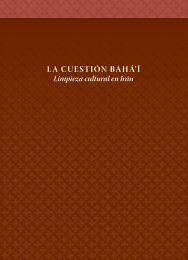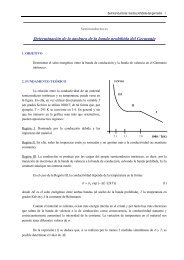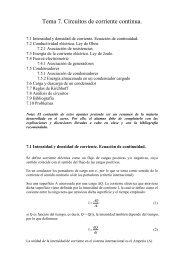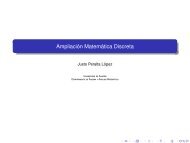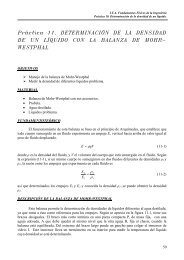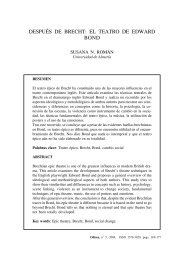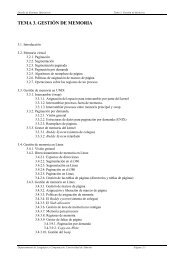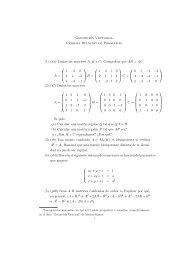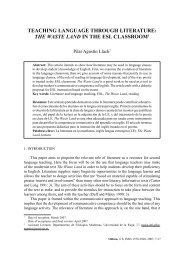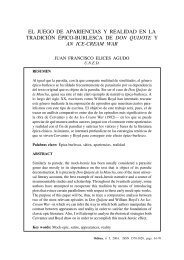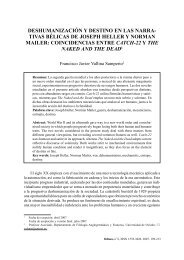A cross-cultural analysis of the generic structure - Universidad de ...
A cross-cultural analysis of the generic structure - Universidad de ...
A cross-cultural analysis of the generic structure - Universidad de ...
You also want an ePaper? Increase the reach of your titles
YUMPU automatically turns print PDFs into web optimized ePapers that Google loves.
Pilar Mur Dueñas<br />
A <strong>cross</strong>-<strong>cultural</strong> <strong>analysis</strong> <strong>of</strong> <strong>the</strong> <strong>generic</strong> <strong>structure</strong>... 123<br />
A CROSS-CULTURAL ANALYSIS OF THE GENERIC<br />
STRUCTURE OF BUSINESS MANAGEMENT RE-<br />
SEARCH ARTICLES: THE METHODS SECTION 1<br />
Pilar Mur Dueñas 2<br />
Abstract: Many studies have focused on <strong>the</strong> <strong>analysis</strong> <strong>of</strong> each <strong>of</strong> <strong>the</strong> prototypical four<br />
sections <strong>of</strong> <strong>the</strong> research article (i.e. Introduction, Methods, Results, Discussion, Swales<br />
1990). However, whereas some sections have been subject to a great <strong>de</strong>al <strong>of</strong> <strong>analysis</strong>,<br />
especially <strong>the</strong> Introduction, o<strong>the</strong>rs have not attracted as much scholarly attention. That<br />
is <strong>the</strong> case <strong>of</strong> <strong>the</strong> Methods section. Never<strong>the</strong>less, it is believed that <strong>the</strong> particular organization<br />
and content <strong>of</strong> this section plays a crucial role in <strong>the</strong> production <strong>of</strong> a successful<br />
research article. The Methods sections <strong>of</strong> 24 research articles in Business Management<br />
written in English for an international rea<strong>de</strong>rship and in Spanish for a local audience will<br />
be contrastively analysed in terms <strong>of</strong> <strong>the</strong>ir rhetorical organization. When comparing <strong>the</strong><br />
results to those from previous analyses in <strong>the</strong> field <strong>of</strong> medicine, it stems that <strong>the</strong> Method<br />
sections in Business Management articles contains some specific steps which could be<br />
consi<strong>de</strong>red characteristic. Fur<strong>the</strong>r, <strong>the</strong> results from <strong>the</strong> <strong>analysis</strong> <strong>of</strong> <strong>the</strong> comparable corpus<br />
indicate that <strong>the</strong>re are certain differences in <strong>the</strong> extent <strong>of</strong> inclusion <strong>of</strong> some steps in <strong>the</strong><br />
research articles in <strong>the</strong> two <strong>cultural</strong> contexts. It seems that both <strong>the</strong> disciplinary culture<br />
and <strong>the</strong> broad <strong>cultural</strong> context in which <strong>the</strong> research articles are written may shape and<br />
constraint <strong>the</strong> micro<strong>structure</strong> <strong>of</strong> <strong>the</strong> Methods sections.<br />
Keywords: Research article, <strong>generic</strong> <strong>structure</strong>, methods section, disciplinary cultures,<br />
inter<strong>cultural</strong> rhetoric.<br />
Resumen: Muchos estudios se han centrado en el análisis <strong>de</strong> las cuatro secciones prototípicas<br />
<strong>de</strong>l artículo <strong>de</strong> investigación (Introducción, Métodos, Resultados y Discusión,<br />
Swales 1990). Sin embargo, mientras algunas <strong>de</strong> estas secciones han sido el foco <strong>de</strong><br />
numerosos estudios, en particular la Introducción, otras no han recibido tanta atención.<br />
Éste es el caso <strong>de</strong> la sección <strong>de</strong> métodos. A pesar <strong>de</strong> ello, se consi<strong>de</strong>ra que el contenido y<br />
la organización estructural <strong>de</strong> esta sección juegan un papel importante en la consecución<br />
<strong>de</strong> un artículo <strong>de</strong> investigación a<strong>de</strong>cuado. Este artículo analiza la sección <strong>de</strong> Métodos <strong>de</strong><br />
24 artículos <strong>de</strong> investigación en el campo <strong>de</strong> la Dirección y Organización <strong>de</strong> Empresas<br />
escritos en inglés para la comunidad internacional y en castellano para una audiencia<br />
local en relación a su organización retórica. Al comparar los resultados con los obtenidos<br />
en estudios previos, se constata que la sección <strong>de</strong> Métodos <strong>de</strong> los artículos <strong>de</strong> Dirección<br />
y Organización <strong>de</strong> Empresas contiene algunos steps (o sub-secciones retóricas) que le<br />
1<br />
Date <strong>of</strong> reception: March 2007.<br />
Date <strong>of</strong> acceptance and final version: April 2007.<br />
This research has been carried out within <strong>the</strong> framework <strong>of</strong> <strong>the</strong> research project InterLAE, financially supported<br />
by <strong>the</strong> Diputación General <strong>de</strong> Aragón (245-122) and <strong>the</strong> Ministerio <strong>de</strong> Educación y Ciencia (“El inglés<br />
y la ciencia: la voz <strong>de</strong>l autor en la expresión y difusión <strong>de</strong>l conocimiento científico. Análisis contrastivo <strong>de</strong> los<br />
recursos lingüísticos <strong>de</strong> la valoración en un corpus <strong>de</strong> textos académicos” HUM2005-03646).<br />
2<br />
Research Fellow, Departamento <strong>de</strong> Filología Inglesa y Alemana, <strong>Universidad</strong> <strong>de</strong> Zaragoza; pmur@<br />
unizar.es<br />
Odisea, n º 8, ISSN 1578-3820, 2007, 123-137
124 Pilar Mur Dueñas<br />
A <strong>cross</strong>-<strong>cultural</strong> <strong>analysis</strong> <strong>of</strong> <strong>the</strong> <strong>generic</strong> <strong>structure</strong>...<br />
son propios. Por otra parte, los resultados obtenidos <strong>de</strong>l análisis <strong>de</strong>l corpus comparable<br />
indican que existen diferencias en la inclusión <strong>de</strong> ciertos steps en los artículos en los dos<br />
contextos <strong>cultural</strong>es. Parece que tanto la comunidad disciplinar como el ámbito <strong>cultural</strong><br />
global en los que se enmarcan los artículos <strong>de</strong> investigación <strong>de</strong>terminan y constriñen la<br />
micro-estructura <strong>de</strong> la sección <strong>de</strong> Métodos.<br />
Palabras clave: Artículo <strong>de</strong> investigación, estructura genérica, la sección <strong>de</strong> métodos,<br />
culturas disciplinares, retórica inter<strong>cultural</strong>.<br />
1. INTRODUCTION<br />
Since Swales (1981, 1990) established <strong>the</strong> prototypical IMRD (Introduction, Methods,<br />
Results, Discussion) <strong>structure</strong> for <strong>the</strong> RA (research article), many linguists have un<strong>de</strong>rtaken<br />
<strong>the</strong> <strong>analysis</strong> <strong>of</strong> <strong>the</strong> rhetorical <strong>structure</strong> <strong>of</strong> this genre. Specially numerous have been <strong>the</strong><br />
studies <strong>of</strong> <strong>the</strong> Introduction in RAs from several disciplines written in English by native<br />
and non-native speakers (i.e. Crookes 1985; Taylor and Tingguang 1991; Lin<strong>de</strong>rberg 1995;<br />
Nwogu 1997; Posteguillo 1999) as well as those which adopt a <strong>cross</strong>-<strong>cultural</strong> perspective<br />
(i.e. Duszak 1994; Burgess 2002). These studies generally conclu<strong>de</strong> that <strong>the</strong> CARS mo<strong>de</strong>l<br />
(i.e. Establishing a territory, Establishing a niche, Occupying <strong>the</strong> niche) proposed by<br />
Swales (1990) is not usually consistently applied, that is, that certain moves (sub-sections<br />
which fulfil a sub-rhetorical function) and/or steps (minor sub-sections within <strong>the</strong> latter)<br />
tend to be <strong>de</strong>leted in particular fields and/or in particular national <strong>cultural</strong> contexts and that<br />
<strong>the</strong> or<strong>de</strong>r <strong>of</strong> appearance <strong>of</strong> <strong>the</strong>se moves and steps may be altered according to <strong>the</strong>se two<br />
factors. These findings, thus, seem to indicate that <strong>the</strong> rhetorical <strong>structure</strong> <strong>of</strong> <strong>the</strong> RA is to<br />
some extent <strong>de</strong>pen<strong>de</strong>nt on <strong>the</strong> discipline to which it belongs and/or <strong>the</strong> linguistic/<strong>cultural</strong><br />
context in which it is written.<br />
Although not as extensively as <strong>the</strong> Introduction, <strong>the</strong> o<strong>the</strong>r three sections <strong>of</strong> <strong>the</strong> RA have<br />
also been <strong>the</strong> object <strong>of</strong> some rhetorical and linguistic research. The RA Results section<br />
has been analysed in several disciplines: Sociology (Brett 1994), Medicine (Nwogu 1997;<br />
Williams 1999), Computer Science (Posteguillo 1999). Likewise, <strong>the</strong> Discussion section <strong>of</strong><br />
RAs in Irrigation and Drainage (Hopkins and Dudley-Evans 1988), Dhemical Engineering<br />
(Peng 1987) and History, Politics and Sociology (Holmes 1997) RAs has also been subject<br />
<strong>of</strong> <strong>analysis</strong>. Finally, <strong>the</strong> section on which <strong>the</strong> present article will focus, Methods, seems to<br />
have attracted <strong>the</strong> least attention. Not only has research been less pr<strong>of</strong>use in relation to <strong>the</strong><br />
Results, Discussion and in<strong>de</strong>ed Methods sections <strong>of</strong> <strong>the</strong> RA, but also <strong>cross</strong>-<strong>cultural</strong> studies<br />
<strong>of</strong> <strong>the</strong>se three sections are very scarce, if at all found. The aim <strong>of</strong> this paper is to provi<strong>de</strong><br />
some evi<strong>de</strong>nce on <strong>the</strong> rhetorical organization <strong>of</strong> <strong>the</strong> Methods section in RAs, focusing on<br />
a corpus <strong>of</strong> texts from a single social science, Business Management, written in and for<br />
two different <strong>cultural</strong> contexts: <strong>the</strong> American international context and <strong>the</strong> Spanish national<br />
context.<br />
As highlighted above, studies <strong>of</strong> <strong>the</strong> RA Methods sections are scarce. Never<strong>the</strong>less, a few<br />
studies have been found. Conduit and Mo<strong>de</strong>sto (1990) analyse a PhD <strong>the</strong>sis and 5 journal<br />
articles in <strong>the</strong> field <strong>of</strong> pharmacology at a <strong>generic</strong> and discoursal level. The pattern that arises<br />
from <strong>the</strong>ir <strong>generic</strong> <strong>analysis</strong> <strong>of</strong> <strong>the</strong> Materials/Methods section is: [X1] ^ [Y] ^ (Obs) where<br />
Odisea, n º 8, ISSN 1578-3820, 2007, 123-137
Pilar Mur Dueñas<br />
A <strong>cross</strong>-<strong>cultural</strong> <strong>analysis</strong> <strong>of</strong> <strong>the</strong> <strong>generic</strong> <strong>structure</strong>... 125<br />
X1 = animate or inanimate participant, Y = process (lexical verb) and Obs = observation.<br />
This is a simplified pattern, which may only apply to this particular hard science; it may be<br />
hypo<strong>the</strong>sized that a different, perhaps more intricate, section will result from <strong>the</strong> <strong>de</strong>scription<br />
<strong>of</strong> <strong>the</strong> procedures followed in a social science such as Business Management.<br />
Ano<strong>the</strong>r study which focuses on <strong>the</strong> Methods section <strong>of</strong> <strong>the</strong> RA is that <strong>of</strong> Nwogu (1997).<br />
His <strong>analysis</strong> <strong>of</strong> 30 texts from 5 medical journals reveals <strong>the</strong> following typical sequence <strong>of</strong><br />
moves in this section <strong>of</strong> <strong>the</strong> RA:<br />
Method<br />
Move 4: Describing Data-Collection Procedure:<br />
by (1) Indicating source <strong>of</strong> data<br />
(2) Indicating data size<br />
(3) Indicating criteria for data collection<br />
Move 5: Describing Experimental Procedures:<br />
by (1) I<strong>de</strong>ntification <strong>of</strong> main research apparatus<br />
(2) Recounting experimental process<br />
(3) Indicating criteria for success<br />
Move 6: Describing Data-Analysis Procedures:<br />
by (1) Defining terminologies<br />
(2) Indicating process <strong>of</strong> data classification<br />
(3) I<strong>de</strong>ntifying analytical instrument/procedure<br />
(4) Indicating modification to instrument/<br />
procedure.<br />
(Nwogu 1997)<br />
Table 1. Moves and constituent elements in <strong>the</strong> Methods section <strong>of</strong> medical RAs.<br />
Finally, in a manual <strong>of</strong>fering a general overview on how to write an RA in English<br />
internationally aimed at Spanish scholars, Coll García (2002) establishes a pattern <strong>of</strong> moves<br />
and steps to be inclu<strong>de</strong>d in <strong>the</strong> Methods sections.<br />
Odisea, n º 8, ISSN 1578-3820, 2007, 123-137
126 Pilar Mur Dueñas<br />
A <strong>cross</strong>-<strong>cultural</strong> <strong>analysis</strong> <strong>of</strong> <strong>the</strong> <strong>generic</strong> <strong>structure</strong>...<br />
Secuencia 1ª: Presentación somera <strong>de</strong> los objetivos <strong>de</strong> la investigación<br />
Secuencia 2ª: Materiales<br />
Unidad informativa 2.1. Sujetos experimentales/muestra<br />
Unidad informativa 2.2. Materiales propiamente dichos<br />
Unidad informativa 2.3. Técnicas <strong>de</strong> experimentación<br />
Unidad informativa 2.4. Equipo <strong>de</strong> investigación<br />
Unidad informativa 2.5. Instrumentos<br />
Secuencia 3ª: Diseño experimental<br />
Unidad informativa 3.1. I<strong>de</strong>ntificación<br />
Unidad informativa 3.2. Descripción<br />
Unidad informativa 3.3. Justificación / argumentación<br />
Unidad informativa 3.4. Limitaciones / restricciones<br />
Secuencia 4ª: Formulación <strong>de</strong> hipótesis<br />
Secuencia 5ª: Descripción <strong>de</strong>l procedimiento experimental y <strong>de</strong>l proceso <strong>de</strong> recogida <strong>de</strong> datos<br />
Unidad informativa 5.1. Descripción procedimental <strong>de</strong>l experimento<br />
Unidad informativa 5.2. Descripción <strong>de</strong>l proceso <strong>de</strong> recogida <strong>de</strong> datos<br />
Secuencia 6ª: Procedimiento <strong>de</strong> análisis <strong>de</strong> datos<br />
Unidad informativa 6.1. Proceso <strong>de</strong> clasificación <strong>de</strong> datos<br />
Unidad informativa 6.2. Variables<br />
Unidad informativa 6.3. Procedimientos analíticos utilizados/tratamiento estadístico<br />
Unidad informativa 6.4. Definición terminológica<br />
Unidad informativa 6.5. Criterios seguidos para <strong>de</strong>terminar el éxito o el fracaso <strong>de</strong>l<br />
experimento o estudio.<br />
(Coll García 2002)<br />
Table 2. Sequences and information units in <strong>the</strong> Methods section <strong>of</strong> an RA in English.<br />
These two patterns within <strong>the</strong> RA Methods will be taken as a point <strong>of</strong> <strong>de</strong>parture for <strong>the</strong><br />
<strong>analysis</strong> <strong>of</strong> this section in <strong>the</strong> corpus un<strong>de</strong>r <strong>analysis</strong>. However, given <strong>the</strong> general nature <strong>of</strong><br />
Coll García’s (2002) sequencing and <strong>the</strong> fact that Nwogu’s (1997) pattern stems from <strong>the</strong><br />
<strong>analysis</strong> <strong>of</strong> RAs in <strong>the</strong> medical field, it is expected that <strong>the</strong> micro-rhetorical <strong>structure</strong> to<br />
arise from analysing <strong>the</strong> BM RAs in <strong>the</strong> corpus will differ from <strong>the</strong>m.<br />
2. THE CORPUS<br />
The corpus consists <strong>of</strong> 24 RAs written in English and in Spanish (140,000 words<br />
approximately) in <strong>the</strong> field <strong>of</strong> Business Management. The RAs selected for <strong>the</strong> corpus were<br />
Odisea, n º 8, ISSN 1578-3820, 2007, 123-137
Pilar Mur Dueñas<br />
A <strong>cross</strong>-<strong>cultural</strong> <strong>analysis</strong> <strong>of</strong> <strong>the</strong> <strong>generic</strong> <strong>structure</strong>... 127<br />
taken from 4 different journals published during <strong>the</strong> years 2003 and 2004 in each <strong>of</strong> <strong>the</strong> two<br />
<strong>cultural</strong> contexts: Aca<strong>de</strong>my <strong>of</strong> Management Journal (AMJ), Strategic Management Journal<br />
(SMJ), Journal <strong>of</strong> Management (JM), and Journal <strong>of</strong> International Management (JIM) in<br />
<strong>the</strong> USA and Alta Dirección (AD), Dirección y Organización <strong>de</strong> Empresas (DyO), Revista<br />
Europea <strong>de</strong> Dirección y Economía <strong>de</strong> la Empresa (REDyEE) and Investigaciones Europeas<br />
<strong>de</strong> Dirección y Economía <strong>de</strong> la Empresa (IE) in Spain. Three RAs were selected from each<br />
<strong>of</strong> <strong>the</strong> journals. Only empirical RAs were compiled. The authors <strong>of</strong> <strong>the</strong> RAs selected for<br />
<strong>the</strong> corpus were based at a North American university in <strong>the</strong> case <strong>of</strong> <strong>the</strong> sub-corpus in English<br />
and at a Spanish university in <strong>the</strong> case <strong>of</strong> <strong>the</strong> sub-corpus in Spanish. So, although not<br />
necessarily native speakers <strong>of</strong> one or <strong>the</strong> o<strong>the</strong>r language, <strong>the</strong> authors <strong>of</strong> <strong>the</strong> RAs in English<br />
are scholars acquainted with <strong>the</strong> American aca<strong>de</strong>mic world publishing internationally and<br />
<strong>the</strong> authors <strong>of</strong> <strong>the</strong> RAs in Spanish publish nationally in <strong>the</strong> Spanish context.<br />
The RAs were downloa<strong>de</strong>d from <strong>the</strong> Internet or scanned and subsequently converted<br />
into text format and carefully checked. The s<strong>of</strong>tware Wordsmith Tools (4.0) was used to<br />
carry out <strong>the</strong> quantitative <strong>analysis</strong> <strong>of</strong> <strong>the</strong> corpus, which was supplemented with manual<br />
<strong>analysis</strong>.<br />
3. RESULTS AND DISCUSSION<br />
3.1. The Methods section in business management RAs<br />
The two comprehensive analyses <strong>of</strong> <strong>the</strong> RA Methods section outlined above (Nwogu<br />
1997 and Coll García 2002) have been taken into account along <strong>the</strong> <strong>analysis</strong> <strong>of</strong> this section in<br />
<strong>the</strong> business management RAs in English and Spanish in <strong>the</strong> corpus. However, as expected,<br />
some new steps have been found and some <strong>of</strong> <strong>the</strong> steps proposed by Nwogu (1997) and/or<br />
Coll García (2002) have not appeared in <strong>the</strong> corpus. As pointed out above, this may be <strong>the</strong><br />
result <strong>of</strong> <strong>the</strong> different disciplinary nature <strong>of</strong> <strong>the</strong> RAs analysed by Nwogu (1997) and <strong>the</strong> ones<br />
analysed here and <strong>the</strong> general character <strong>of</strong> Coll García’s (2002) sequence which is posited<br />
as applicable to a wi<strong>de</strong> range <strong>of</strong> fields. Ra<strong>the</strong>r than outlining steps grouped un<strong>de</strong>r moves<br />
–as Nwogu (1997) and Coll García (2002) do–, only steps are outlined in relation to <strong>the</strong><br />
business management RAs analysed. This is a result <strong>of</strong> not perceiving that steps are regularly<br />
encompassed un<strong>de</strong>r a superordinate move. The steps that have appeared at some point in<br />
<strong>the</strong> Methods sections <strong>of</strong> <strong>the</strong> business management RAs in <strong>the</strong> comparable corpus are:<br />
1. Describing participants/<strong>the</strong> sample: <strong>the</strong> number <strong>of</strong> participants or firms that took part<br />
in <strong>the</strong> research is outlined toge<strong>the</strong>r with some information about <strong>the</strong>m, setting <strong>the</strong><br />
context in which <strong>the</strong> research was carried out. Sometimes also <strong>the</strong> rationale and/or<br />
criteria in <strong>the</strong> selection <strong>of</strong> participants is inclu<strong>de</strong>d here.<br />
(1A) A total <strong>of</strong> 92 call center CSRs employed by a financial services institution participated<br />
in <strong>the</strong> study. Of <strong>the</strong> 92, 20 (22%) were men, 72 (78%) were women,<br />
40 (43%) were non-minorities, and 52 (57%) were minorities. (JM2) 3<br />
3<br />
The information between brackets indicates <strong>the</strong> journal and <strong>the</strong> specific article from that journal from which<br />
<strong>the</strong> example has been drawn.<br />
Odisea, n º 8, ISSN 1578-3820, 2007, 123-137
128 Pilar Mur Dueñas<br />
A <strong>cross</strong>-<strong>cultural</strong> <strong>analysis</strong> <strong>of</strong> <strong>the</strong> <strong>generic</strong> <strong>structure</strong>...<br />
(1B) Hemos seleccionado una muestra homogénea <strong>de</strong> empresas a nivel nacional, en<br />
el sentido <strong>de</strong> que son empresas que han recibido en algún momento una subvención<br />
por parte <strong>de</strong>l CDTI (Centro para el Desarrollo Tecnológico Industrial)<br />
-consi<strong>de</strong>rándolas como PYMES innovadoras. (REDyEE2)<br />
2. Describing data collection procedure: <strong>the</strong> steps followed in <strong>the</strong> distribution <strong>of</strong> questionnaires<br />
or in <strong>the</strong> selection <strong>of</strong> <strong>the</strong> sample tend to be indicated as well as <strong>the</strong> reasons<br />
for exclusion <strong>of</strong> some participants.<br />
(2A) Hospital executives were pre-notified <strong>of</strong> <strong>the</strong> survey two weeks before <strong>the</strong> initial<br />
mailing. Survey instruments were mailed along with a letter <strong>of</strong> endorsement<br />
from <strong>the</strong> presi<strong>de</strong>nt <strong>of</strong> <strong>the</strong> hospital association, and instructions explaining <strong>the</strong><br />
study. (JM3)<br />
(2B) La configuración <strong>de</strong>l listado <strong>de</strong> empresas se hizo a partir <strong>de</strong> la base <strong>de</strong> datos<br />
SABE (Sistema <strong>de</strong> Análisis <strong>de</strong> Balances Españoles), quedando la población<br />
<strong>de</strong>finitiva conformada por 136 firmas. (DyO2)<br />
3. Describing data collection results: <strong>the</strong> final number <strong>of</strong> participants or <strong>the</strong> final size<br />
<strong>of</strong> <strong>the</strong> sample is stated, after some exclusion procedure was imputed.<br />
(3A) Including both rounds <strong>of</strong> surveys, firms representing 212 acquisitions respon<strong>de</strong>d<br />
to at least one survey. Both surveys were completed by 114 participants (39%),<br />
with sufficiently complete information on <strong>the</strong> key variables completed by 77<br />
firms (27%), which provi<strong>de</strong>s <strong>the</strong> final sample for this study. (JM1)<br />
(3B) Des<strong>de</strong> entonces y hasta febrero <strong>de</strong> 2002 se recibieron un total <strong>de</strong> 368 respuestas<br />
lo que supone un ratio <strong>de</strong> respuesta aceptable <strong>de</strong>l 13,45%. (IE2)<br />
4. Outlining variables and measures: this step may be <strong>the</strong> consequence <strong>of</strong> <strong>the</strong> experimental<br />
nature <strong>of</strong> <strong>the</strong> RAs in <strong>the</strong> corpus. Managerial and practical cases seem to<br />
entail <strong>the</strong> establishment and <strong>analysis</strong> <strong>of</strong> particular, relevant variables; each variable<br />
is presented (and commonly <strong>de</strong>fined) toge<strong>the</strong>r with <strong>the</strong> measure by means <strong>of</strong> which<br />
it will be analysed.<br />
(4A) To measure size-based imitation (trait imitation), we first <strong>de</strong>termined <strong>the</strong> number<br />
<strong>of</strong> employees employed by each firm in our sample in 1989. We ga<strong>the</strong>red<br />
data on firrn size using <strong>the</strong> database Research Insight. Then, for each given<br />
source, we averaged <strong>the</strong> sizes <strong>of</strong> all <strong>the</strong> firms that hired from it between 1987<br />
and 1989. (AMJ3)<br />
(4B) Para la medición <strong>de</strong>l aprendizaje organizativo se ha optado por <strong>de</strong>sarrollar una<br />
escala que reconozca el carácter multidimensional <strong>de</strong>l aprendizaje y recoja <strong>de</strong><br />
forma explícita información acerca <strong>de</strong> las cuatro dimensiones <strong>de</strong>l aprendizaje<br />
i<strong>de</strong>ntificadas teóricamente: adquisición <strong>de</strong> conocimiento, distribución, interpretación<br />
y memoria organizativa. (IE1)<br />
5. Describing data-<strong>analysis</strong> procedure: ra<strong>the</strong>r than indicating <strong>the</strong> particular variable(s)<br />
and measure(s) analysed, in this step more general statements about <strong>the</strong> methodological<br />
process are ma<strong>de</strong>.<br />
Odisea, n º 8, ISSN 1578-3820, 2007, 123-137
Pilar Mur Dueñas<br />
A <strong>cross</strong>-<strong>cultural</strong> <strong>analysis</strong> <strong>of</strong> <strong>the</strong> <strong>generic</strong> <strong>structure</strong>... 129<br />
(5A) Our analyses procee<strong>de</strong>d in two stages. Initially, we conducted preliminary<br />
analyses, assessing <strong>the</strong> overall robustness <strong>of</strong> <strong>the</strong> basic <strong>the</strong>oretical mo<strong>de</strong>l proposed<br />
and tested by Jackson and Dutton (1988). We contrasted a parsimonious<br />
one-factor mo<strong>de</strong>l against <strong>the</strong> two-factor <strong>the</strong>oretical mo<strong>de</strong>l <strong>of</strong> threat discrimination<br />
and opportunity discrimination, using all 12 items i<strong>de</strong>ntified by Jackson<br />
and Dutton. (SMJ3)<br />
(5B) La configuración <strong>de</strong> los diferentes grupos (competitivas y no competitivas) a<br />
partir <strong>de</strong> la valoración <strong>de</strong> la posición relativa <strong>de</strong> las empresas en función <strong>de</strong> los<br />
parámetros propuestos, se realizará siguiendo la metodología que exponemos<br />
a continuación:<br />
1. Calcular, para cada una <strong>de</strong> las 53 empresas <strong>de</strong> la muestra y los cuatro años<br />
<strong>de</strong> análisis, los valores medios <strong>de</strong> cada uno los parámetros clasificadores<br />
(cifra <strong>de</strong> negocios y rentabilidad financiera).<br />
2. Obtención <strong>de</strong> dos conglomerados <strong>de</strong> empresas (competitivas y no competitivas)<br />
mediante la aplicación <strong>de</strong>l análisis cluster a los resultados obtenidos<br />
en el paso anterior. (IE3)<br />
6. Reference to previous literature: citations are inclu<strong>de</strong>d along <strong>the</strong> RA, including <strong>the</strong><br />
Methods section.<br />
(6A) Patterns <strong>of</strong> favor exchange, status, and productivity may be driven, in part, by<br />
access to resource (e.g., Biau 1963; Long 1998). (AMJ2)<br />
(6B) La calidad percibida la enten<strong>de</strong>mos, siguiendo a Zeithami (1988), como un<br />
juicio subjetivo <strong>de</strong>l consumidor sobre la excelencia o superioridad <strong>de</strong> un<br />
producto. (REDyEE1)<br />
7. Reference to past research which follows a similar methodological procedure: it seems<br />
important within this discipline to base one’s research not only upon previous work<br />
and previous literature but also upon previously tested empirical techniques. 4<br />
(7A) Several o<strong>the</strong>r scholars have recently used <strong>the</strong> same measure <strong>of</strong> Internet firm<br />
perfor mance (Kotha, Rajgopal and Rindova 2001). The measure has also been<br />
used in <strong>the</strong> study <strong>of</strong> o<strong>the</strong>r new firms in emerging economic sectors, such as<br />
biotechnology (DeCarolis and Deeds, 1999; Stuart et al 1999) and in <strong>the</strong> study<br />
<strong>of</strong> a diversified sam ple <strong>of</strong> IPO firms (Welboume and Andrews 1996; Welboume<br />
and Cyr 1999). (SMJ1)<br />
(7B) Posteriormente, se realizó la codificación <strong>de</strong> la información contenida en esos<br />
artículos, para lo que se utilizó la técnica metodológica <strong>de</strong>l análisis <strong>de</strong> contenido<br />
(Krippendorf 1980). (AD3)<br />
8. Claiming validity: business management scholars tend to make claims that refer to<br />
<strong>the</strong> possible biased measures and analyses and how <strong>the</strong>y took those issues into account<br />
and managed to solve <strong>the</strong>m. This is a clear illustration <strong>of</strong> <strong>the</strong> rea<strong>de</strong>rs’ potential<br />
4<br />
In JM1 <strong>the</strong> following statement is ma<strong>de</strong> “[w]hen possible, existing measures were used with modifications;<br />
o<strong>the</strong>rwise, we <strong>de</strong>veloped new measures”.<br />
Odisea, n º 8, ISSN 1578-3820, 2007, 123-137
130 Pilar Mur Dueñas<br />
A <strong>cross</strong>-<strong>cultural</strong> <strong>analysis</strong> <strong>of</strong> <strong>the</strong> <strong>generic</strong> <strong>structure</strong>...<br />
negatability <strong>of</strong> claims and how it leads scholars to anticipitate any possible negative<br />
opinions on <strong>the</strong> part <strong>of</strong> rea<strong>de</strong>rs. Also, scholars in this discipline try to claim validity<br />
by justifying <strong>the</strong> sample taken and/or <strong>the</strong> variables and measures used.<br />
(8A) In addition to, or instead <strong>of</strong>, technological activity, a JV may be expected to<br />
play a role in <strong>the</strong> manufacturing and/or marketing <strong>of</strong> a biotechnology product.<br />
We <strong>the</strong>refore control for <strong>the</strong> original purpose <strong>of</strong> <strong>the</strong> JV by examining whe<strong>the</strong>r<br />
<strong>the</strong> JV has a manufacturing or marketing agreement. (JIM2)<br />
(8B) Ante la imposibilidad <strong>de</strong> analizar todas las firmas, optamos por seleccionar<br />
las <strong>de</strong> mayor tamaño, entre otras razones porque la creación <strong>de</strong> una alianza<br />
estratégica requiere la disponibilidad <strong>de</strong> un mínimo <strong>de</strong> recursos, siendo el<br />
tamaño un índice <strong>de</strong> esta cualidad. (DyO2)<br />
9. Reference to past research (consistency): some results obtained are compared to<br />
previous work to seek consistency and, hence, credibility. As shown in <strong>the</strong> Tables<br />
below this is a very uncommon step in this section <strong>of</strong> business management RAs. It<br />
is far more common in <strong>the</strong> Discussion section. Never<strong>the</strong>less, it has also been inclu<strong>de</strong>d<br />
in this section in a few occasions in <strong>the</strong> sub-corpus in English.<br />
(9A) This mean value suggests that employees believed, on <strong>the</strong> average, that <strong>the</strong>y<br />
gave more than <strong>the</strong>y received in <strong>the</strong>ir favor exchanges with o<strong>the</strong>r employees,<br />
afinding that is consistent with previous research on egocentric accounting<br />
biases in exchange relationships (e.g., Ross and Sicoly 1979). (AMJ2)<br />
10. Indicating a finding: statements <strong>of</strong> findings in <strong>the</strong> Methods section refer to marginal<br />
analyses, such as for instance, comparing certain variables in fully completed<br />
questionnaires (and hence inclu<strong>de</strong>d in <strong>the</strong> sample) and uncompleted ones (and thus<br />
exclu<strong>de</strong>d from <strong>the</strong> sample), or findings regarding <strong>the</strong> characteristics <strong>of</strong> <strong>the</strong> firms or<br />
participants in <strong>the</strong> sample.<br />
(10A) These means were not significantly different. Differences between respon<strong>de</strong>nts<br />
to both surveys and non-respon<strong>de</strong>nts to ei<strong>the</strong>r survey for firm-level measures <strong>of</strong><br />
size, return on investment and sales growth were also not significant. (JM1)<br />
(10B) Respecto al tamaño <strong>de</strong> la empresa, analizando en primer lugar el volumen <strong>de</strong><br />
facturación, éste evoluciona <strong>de</strong> forma muy favorable. Así, en el momento <strong>de</strong><br />
su constitución –primer año <strong>de</strong> actividad–, la empresa que más facturó fue <strong>de</strong><br />
860 millones al año, pasando a 8350 millones la empresa que más facturó en<br />
1999. En el número <strong>de</strong> empleados se da, también, un incremento notable <strong>de</strong><br />
los mismos con el paso <strong>de</strong>l tiempo, [...] (REDyEE2)<br />
11. Aim/<strong>structure</strong> <strong>of</strong> <strong>the</strong> section: it is usually inclu<strong>de</strong>d at <strong>the</strong> beginning <strong>of</strong> <strong>the</strong> section<br />
to introduce and gui<strong>de</strong> <strong>the</strong> rea<strong>de</strong>r along it.<br />
(11A) The following section will elaborate <strong>the</strong> process un<strong>de</strong>rtaken for data collection<br />
and <strong>the</strong> statistical methodology used in <strong>the</strong> testing <strong>of</strong> <strong>the</strong> hypo<strong>the</strong>ses. (JIM1)<br />
(11B) En este apartado proce<strong>de</strong>remos a explicar <strong>de</strong> forma breve las principales<br />
consi<strong>de</strong>raciones en relación al proceso <strong>de</strong> recogida y análisis <strong>de</strong> información<br />
necesario para este estudio. (AD1)<br />
Two fur<strong>the</strong>r steps have been found only once in <strong>the</strong> whole corpus in <strong>the</strong> Methods sections<br />
and, thus, have not been inclu<strong>de</strong>d in <strong>the</strong> tables below: “Restatement <strong>of</strong> hypo<strong>the</strong>sis”<br />
Odisea, n º 8, ISSN 1578-3820, 2007, 123-137
Pilar Mur Dueñas<br />
A <strong>cross</strong>-<strong>cultural</strong> <strong>analysis</strong> <strong>of</strong> <strong>the</strong> <strong>generic</strong> <strong>structure</strong>... 131<br />
(example 12) and “Claiming centrality” (example 13). They tend to be more common in<br />
<strong>the</strong> Results section (in which <strong>the</strong> origial statement <strong>of</strong> hypo<strong>the</strong>ses is fur<strong>the</strong>r away) and <strong>the</strong><br />
Introduction section (in which <strong>the</strong> research is justified in terms <strong>of</strong> importance, novelty,<br />
etc.), respectively.<br />
(12) Hypo<strong>the</strong>ses 2 and 6 predict a curvilinear effect (inverted U-shaped) <strong>of</strong> perceived<br />
imbalance on productivity. (AMJ2)<br />
(13) El sector azulejero español ha mostrado un gran dinamismo, como se aprecia en la<br />
gran cantidad <strong>de</strong> exportaciones realizadas y en la importante evolución tecnológica<br />
iniciada en la segunda mitad <strong>de</strong> los años ochenta, que ha generado productos <strong>de</strong><br />
una gran calidad y diseño. Este gran dinamismo ha hecho necesario el <strong>de</strong>sarrollo <strong>de</strong><br />
organizaciones e instituciones <strong>de</strong> apoyo a las empresas <strong>de</strong>l sector. (DyO1)<br />
Some <strong>of</strong> <strong>the</strong> steps outlined above are similar to <strong>the</strong> ones proposed by <strong>the</strong>se two scholars.<br />
Step 1 above could be consi<strong>de</strong>red parallel to Nwogu’s (1997) step “Indicating source <strong>of</strong><br />
data” and to Coll García’s (2002) information unit “Sujetos experimentales/muestra”. Step<br />
2, “Describing data collection procedure”, which constitutes move 4 in Nwogu’s (1997)<br />
pattern and Coll García’s (2002) fifth sequence, is seen here as a more concise step in which<br />
only how <strong>the</strong> data was obtained (by means <strong>of</strong> a questionnaire, through a database, etc.) is<br />
co<strong>de</strong>d. Step 3, “Describing data collection results”, inclu<strong>de</strong>s Nwogu’s (1997) step “Indicating<br />
data size” plus <strong>the</strong> criteria for excluding some participants. Step 8, “Claiming validity”, is<br />
seen as a general step in that validity can be claimed by justifying criteria <strong>of</strong> inclusion and<br />
exclusion from <strong>the</strong> sample, by arguing appropriateness <strong>of</strong> measures, etc.; in that sense, it may<br />
be consi<strong>de</strong>red to be related to Nwogu’s (1997) step “Indicating criteria for success” and Coll<br />
García’s (2002) steps “Justificación/argumentación” and “Limitaciones/restricciones”. On<br />
<strong>the</strong> o<strong>the</strong>r hand, some moves in Nwogu’s (1997) and Coll García’s (2002) formats have not<br />
been regularly found in <strong>the</strong> corpus: “Describing experimental procedures”, “Formulación<br />
<strong>de</strong> hipótesis” and “Diseño experimental”; nei<strong>the</strong>r have been found some <strong>of</strong> <strong>the</strong> steps <strong>the</strong>y<br />
put forward: “Indicating process <strong>of</strong> data classification”, “I<strong>de</strong>ntifying analytical instrument/<br />
procedure”, “Indicating modification to instrument/procedure”, which may be specific to<br />
medical research, “Defining terminologies”, “Definiciones terminológicas”, which have<br />
been found to appear in <strong>the</strong> Introduction section in <strong>the</strong> comparable corpus, “Técnicas <strong>de</strong><br />
investigación”, “Instrumentos” and a few more. Finally, some steps have been discerned<br />
which were not inclu<strong>de</strong>d in <strong>the</strong>ir patterns: “Outlining variables and measures”, 5 “Reference to<br />
previous literature” and “Reference to past research which follows a similar methodological<br />
procedure”. On <strong>the</strong> whole, <strong>the</strong>n, <strong>the</strong> Methods sections <strong>of</strong> business management RAs seem<br />
to share certain similarities in <strong>the</strong> type <strong>of</strong> information co<strong>de</strong>d with medical RA Methods<br />
sections, but also to have <strong>the</strong>ir own characteristic sub-rhetorical particularities.<br />
3.2. Comparing English and Spanish business management RA Methods sections<br />
Although most steps outlined above have been found both in <strong>the</strong> sub-corpus in English<br />
and in <strong>the</strong> sub-corpus in Spanish, some <strong>of</strong> <strong>the</strong>m have not been inclu<strong>de</strong>d to <strong>the</strong> same extent<br />
in <strong>the</strong> two sub-corpora. The following two tables summarise <strong>the</strong> extent <strong>of</strong> (non)inclusion<br />
5<br />
Coll García (2002) establishes <strong>the</strong> information unit “variables”, which is slightly different, since it has been<br />
found that in <strong>the</strong> BM RAs variables are accompanied by <strong>the</strong> corresponding measures.<br />
Odisea, n º 8, ISSN 1578-3820, 2007, 123-137
132 Pilar Mur Dueñas<br />
A <strong>cross</strong>-<strong>cultural</strong> <strong>analysis</strong> <strong>of</strong> <strong>the</strong> <strong>generic</strong> <strong>structure</strong>...<br />
<strong>of</strong> <strong>the</strong> steps presented above in <strong>the</strong> business management RAs in English (Table 3) and in<br />
Spanish (Table 4):<br />
1 2 3 4 5 6 7 8 9 10 11 TOTAL<br />
AMJ1 + + + + + 5<br />
AMJ2 + + + + + + + + 8<br />
AMJ3 + + + + + + + + 8<br />
JM1 + + + + + + + + + 9<br />
JM2 + + + + + 5<br />
JM3 + + + + + + + + 8<br />
SMJ1 + + + + + + + 7<br />
SMJ2 + + + + + + + 7<br />
SMJ3 + + + + + + + + + 9<br />
JIM1 + + + + + + + + + 9<br />
JIM2 + + + + + + + 7<br />
JIM3 + + + + + + + + + 9<br />
TOTAL 12 11 9 12 8 10 12 11 2 4 1<br />
Table 3. Steps in <strong>the</strong> Methods section <strong>of</strong> <strong>the</strong> business management RAs in English.<br />
1 2 3 4 5 6 7 8 9 10 11 TOTAL<br />
AD1 + + + + + 5<br />
AD2 + + + + + 5<br />
AD3 + + + + + + 6<br />
DyO1 + + + + + + 6<br />
DyO2 + + + + + 5<br />
DyO3 + + + + + + 6<br />
REDy-<br />
EE1<br />
+ + + + + + + 7<br />
REDy-<br />
EE2<br />
+ + + 1 + + 5<br />
REDy-<br />
EE3<br />
+ + + + + + + + + 9<br />
IE1 + + + + + + 6<br />
IE2 + + + + 4<br />
IE3 + + + + + + + + 8<br />
TOTAL 12 12 9 8 5 5 5 8 0 5 3<br />
Table 4. Steps in <strong>the</strong> Methods section <strong>of</strong> <strong>the</strong> business management RAs in Spanish.<br />
In <strong>the</strong> sub-corpus in English “Method(s)” seems to be <strong>the</strong> preferred heading un<strong>de</strong>r<br />
which this section is inclu<strong>de</strong>d, appearing in 8 RAs. O<strong>the</strong>r headings found in this section<br />
Odisea, n º 8, ISSN 1578-3820, 2007, 123-137
Pilar Mur Dueñas<br />
A <strong>cross</strong>-<strong>cultural</strong> <strong>analysis</strong> <strong>of</strong> <strong>the</strong> <strong>generic</strong> <strong>structure</strong>... 133<br />
are “Research method”, “Research methodology”, “Research data and methodology” and<br />
“Methodology”. Un<strong>de</strong>r <strong>the</strong>se headings many diverse sub-headings have been inclu<strong>de</strong>d.<br />
All Methods sections in English have inclu<strong>de</strong>d at least one sub-heading, which frequently,<br />
though not necessarily, indicate <strong>the</strong> step(s) covered. It has been found, for instance, that<br />
<strong>the</strong> sub-heading “Analyses” is not necessary for <strong>the</strong> step “Describing data-<strong>analysis</strong> procedure”<br />
to appear in <strong>the</strong> Methods section. It is interesting to note that <strong>de</strong>spite <strong>the</strong> diversity<br />
in <strong>the</strong> sub-headings used (“Participants and procedures”, “Measures”, “Sample”, “Research<br />
setting”, “Analysis”, “Non-response bias”, “Data collection”, “Sample selection”,<br />
“Measurement <strong>of</strong> variables”, “Statistical methodology”, “Depen<strong>de</strong>nt variable measures”,<br />
“In<strong>de</strong>pen<strong>de</strong>nt variable measures”), <strong>the</strong> range and number <strong>of</strong> steps inclu<strong>de</strong>d in this section<br />
<strong>of</strong> <strong>the</strong> business management RAs in English is very similar. With <strong>the</strong> exception <strong>of</strong> AMJ1<br />
JM2, Methods sections in English present 7 to 9 steps. Three steps appear to be compulsory<br />
in <strong>the</strong> Methods sections <strong>of</strong> business management RAs published in English internationally<br />
as <strong>the</strong>y have been inclu<strong>de</strong>d in all RAs in <strong>the</strong> corpus: “Describing participants/<strong>the</strong> sample”,<br />
“Outlining variables and measures” and “Reference to past research which follows a similar<br />
methodological procedure”. Two o<strong>the</strong>r steps have been found in all RAs in <strong>the</strong> corpus but<br />
one: “Describing data collection procedure” and “Claiming validity”.<br />
In <strong>the</strong> business management RAs in Spanish <strong>the</strong> heading “Metodología” has been<br />
most extensively used, appearing just in 5 RAs. Similar headings have been used in 2<br />
RAs “Metodología <strong>de</strong> la investigación” and “Metodología y universo consi<strong>de</strong>rado”. O<strong>the</strong>r<br />
headings used are “Diseño <strong>de</strong> la investigación y metodología”, “Materiales y métodos”<br />
and “Estudio empírico”. Two RAs presented no general heading (DyO2, REDyEE1) and<br />
five RAs presented no sub-headings, thus not providing <strong>the</strong> rea<strong>de</strong>r with visible clues about<br />
<strong>the</strong> changing communicative purpose <strong>of</strong> <strong>the</strong> section. 6 In addition, <strong>the</strong> range and number <strong>of</strong><br />
steps inclu<strong>de</strong>d in <strong>the</strong> Spanish RA Methods sections have been found to be less homogenous<br />
than in <strong>the</strong> English Methods sections. The number <strong>of</strong> steps inclu<strong>de</strong>d range from 5 to 9 steps.<br />
Whereas in <strong>the</strong> English sub-corpus steps 1 to 8 (<strong>the</strong> most frequent ones) in <strong>the</strong> Methods<br />
sections were inclu<strong>de</strong>d in 8 to 12 RAs in <strong>the</strong> Spanish sub-corpus, <strong>the</strong>y were inclu<strong>de</strong>d in<br />
5 to 12 RAs. Two steps have been inclu<strong>de</strong>d in all Spanish RAs, “Describing participants/<br />
<strong>the</strong> sample” and “Describing data collection procedure”. O<strong>the</strong>r seemingly compulsory<br />
steps in <strong>the</strong> English RA Methods section, such as “Outlining variables and measures” and<br />
“Reference to past research which follows a similar methodological procedure”, cannot be<br />
consi<strong>de</strong>red so in <strong>the</strong> Spanish sub-corpus, as <strong>the</strong>y appeared only in 8 and 5 Spanish RAs,<br />
respectively. In fact, <strong>the</strong> greatest difference between both sub-corpora in <strong>the</strong> rhetorical<br />
micro-<strong>structure</strong> <strong>of</strong> this section has been found in <strong>the</strong> extent <strong>of</strong> inclusion <strong>of</strong> step 7 “Reference<br />
to past research which follows a similar methodological procedure”. Whereas all Methods<br />
sections in English inclu<strong>de</strong>d citations <strong>of</strong> previous work which successfully followed <strong>the</strong><br />
methodological procedure presented, only 5 RAs in Spanish inclu<strong>de</strong>d this type <strong>of</strong> references.<br />
The second greatest difference refers to step 6 “Reference to previous literature”, which<br />
6<br />
The scarcer number <strong>of</strong> headings and sub-headings in <strong>the</strong> Spanish sections <strong>of</strong> <strong>the</strong> RA than in <strong>the</strong> ones in<br />
English can be a consequence <strong>of</strong> <strong>the</strong> rea<strong>de</strong>r-responsible style and <strong>the</strong> writer-responsible style (Hinds 1987) that<br />
tend to characterise texts in <strong>the</strong> two <strong>cultural</strong> contexts. In <strong>the</strong> Spanish BM RAs, rea<strong>de</strong>rs seem to be provi<strong>de</strong>d with<br />
less guidance as regards <strong>the</strong> changing communicative purpose <strong>of</strong> <strong>the</strong> RA and its internal micro-<strong>structure</strong>, which<br />
would be in line with <strong>the</strong> alledgedly rea<strong>de</strong>r-responsible style favoured in <strong>the</strong> Spanish language and context.<br />
Odisea, n º 8, ISSN 1578-3820, 2007, 123-137
134 Pilar Mur Dueñas<br />
A <strong>cross</strong>-<strong>cultural</strong> <strong>analysis</strong> <strong>of</strong> <strong>the</strong> <strong>generic</strong> <strong>structure</strong>...<br />
has been inclu<strong>de</strong>d in fewer RAs in Spanish than in English; 10 RAs in English ma<strong>de</strong> also<br />
reference or reviewed <strong>the</strong> literature in <strong>the</strong> field, but only 5 RAs in Spanish inclu<strong>de</strong>d any<br />
such references. Also significant is <strong>the</strong> different extent <strong>of</strong> inclusion <strong>of</strong> step 8 “Claiming<br />
validity”, which was found in 11 RAs in English and in 8 RAs in Spanish.<br />
4. CONCLUDING REMARKS<br />
When contrasting <strong>the</strong> rhetorical micro-<strong>structure</strong> <strong>of</strong> <strong>the</strong> Methods sections in RAs from<br />
different disciplines, some differences arise. In this particular case, some <strong>of</strong> <strong>the</strong> steps which<br />
are found to be characteristic <strong>of</strong> <strong>the</strong> business management RA Methods sections have not<br />
been reported in previous studies <strong>of</strong> this section from RAs in o<strong>the</strong>r disciplines, mainly in<br />
<strong>the</strong> medical field. At <strong>the</strong> same time some <strong>of</strong> <strong>the</strong> steps which were reported in this previous<br />
research in relation to <strong>the</strong> medical RA Methods sections are not found in <strong>the</strong> comparable<br />
corpus <strong>of</strong> business management RAs. Thus, this study provi<strong>de</strong>s more evi<strong>de</strong>nce on <strong>the</strong> already<br />
highlighted issue that <strong>the</strong> disciplinary communities constrain <strong>the</strong> rhetorical conventions <strong>of</strong><br />
aca<strong>de</strong>mic knowledge production (Breivega et al. 2002; Dahl 2004; Hyland 2000, 2005,<br />
among o<strong>the</strong>rs).<br />
Fur<strong>the</strong>r, when <strong>the</strong> rhetorical micro-<strong>structure</strong> <strong>of</strong> <strong>the</strong> Methods sections in English and<br />
in Spanish within <strong>the</strong> same discipline is compared, some differences also come out. Whereas<br />
most steps are found in <strong>the</strong> Methods sections <strong>of</strong> both business management RAs in<br />
English and in Spanish, <strong>the</strong> frequency <strong>of</strong> inclusion <strong>of</strong> some <strong>of</strong> <strong>the</strong>m is ra<strong>the</strong>r different. For<br />
instance, “Reference to past research which follows a similar methodological procedure”,<br />
“Reference to previous literature”, “Claiming validity” and “Describing participants/<strong>the</strong><br />
sample” are steps more commonly inclu<strong>de</strong>d in <strong>the</strong> English RAs; in fact, some <strong>of</strong> <strong>the</strong>se<br />
steps are found in all RAs in <strong>the</strong> English corpus. Also, in general, RA Methods sections in<br />
English seem to be more homogenous in terms <strong>of</strong> <strong>the</strong> type and number <strong>of</strong> steps inclu<strong>de</strong>d<br />
than those in English.<br />
The different socio-<strong>cultural</strong> context in which <strong>the</strong> RAs are written and published may<br />
account for <strong>the</strong>se rhetorical differences. In or<strong>de</strong>r for research to be published internationally<br />
in English in <strong>the</strong> field <strong>of</strong> BM, it may need to follow well-attested methodological<br />
procedures that may have been used in past research. Some <strong>de</strong>partures from previously<br />
used methods may also be accepted as long as <strong>the</strong>y are indicated and justified. In this<br />
context it seems crucial that both in relation to <strong>the</strong> <strong>the</strong>oretical framework and in relation to<br />
<strong>the</strong> methodological procedure, international BM RAs give a sense <strong>of</strong> continuation within<br />
<strong>the</strong> field, carefully rooting <strong>the</strong>ir research in already published work. This grounding <strong>of</strong><br />
<strong>the</strong>ory and methodology on previous studies seems to be less important in <strong>the</strong> case <strong>of</strong> BM<br />
RAs published in a national context, in which also <strong>the</strong> feeling <strong>of</strong> contributing disciplinary<br />
knowledge to <strong>the</strong> community may not be as stark. In addition, citing past research which<br />
follows similar methodological procedure(s) also contributes to justifying <strong>the</strong> research and<br />
to convincing <strong>the</strong> rea<strong>de</strong>r <strong>of</strong> its credibility. Similarly, it is relevant that <strong>the</strong> step “Claiming<br />
validity” is present in more RAs in English than in RAs in Spanish. Because <strong>the</strong> competitiveness<br />
to get a BM RA internationally in English is getting fierce (much more than getting<br />
it published nationally in <strong>the</strong> Spanish context), a persuasive strategy may be to explicitly<br />
Odisea, n º 8, ISSN 1578-3820, 2007, 123-137
Pilar Mur Dueñas<br />
A <strong>cross</strong>-<strong>cultural</strong> <strong>analysis</strong> <strong>of</strong> <strong>the</strong> <strong>generic</strong> <strong>structure</strong>... 135<br />
draw <strong>the</strong> rea<strong>de</strong>rs’ attention upon <strong>the</strong> validity <strong>of</strong> <strong>the</strong> measures and variables to be used, which<br />
entails <strong>the</strong> validity <strong>of</strong> <strong>the</strong> subsequent results.<br />
In conclusion it appears that both <strong>the</strong> small (i.e. disciplinary) and big (i.e. broad, national)<br />
cultures (Atkinson 2004) in which <strong>the</strong> business management RAs are written exert<br />
an influence on <strong>the</strong> type <strong>of</strong> information to be inclu<strong>de</strong>d in <strong>the</strong> Methods section, and for that<br />
matter, on <strong>the</strong> way scientific knowledge is created, organised and distributed among aca<strong>de</strong>mic<br />
peers. It is believed that text-based inter<strong>cultural</strong> analyses such as <strong>the</strong> one presented<br />
here may help unveil significant rhetorical differences in aca<strong>de</strong>mic writing produced in<br />
different contexts, which, in turn, may prove valuable for scholars wishing to publish <strong>the</strong>ir<br />
research in different (inter)national contexts.<br />
REFERENCES<br />
ATKINSON, D. 2004. “Contrasting rhetorics/contrasting cultures: why contrastive rhetoric<br />
needs a better conceptualization <strong>of</strong> culture”. Journal <strong>of</strong> English for Aca<strong>de</strong>mic<br />
Purposes 3, 4: 277-289.<br />
BREIVEGA, K. R., T. DAHL and K. FLØTTUM. 2002. “Traces <strong>of</strong> self and o<strong>the</strong>rs in research<br />
articles. A comparative pilot study <strong>of</strong> English, French and Norwegian research<br />
articles in medicine, economics and linguistics”. International Journal <strong>of</strong> Applied<br />
Lingusitics 12, 2: 218-239.<br />
BRETT, P. 1994. “A genre <strong>analysis</strong> <strong>of</strong> <strong>the</strong> results section <strong>of</strong> sociology articles”. English<br />
for Specifi c Purposes 13, 1: 47-59.<br />
BURGESS, S. 2002. “Packed houses and intimate ga<strong>the</strong>rings: Audience and rhetorical strategies”.<br />
Aca<strong>de</strong>mic Discourse. Ed. John FLOWERDEW. London: Longman. 196-225.<br />
COLL GARCÍA, J. F. 2002. “La sección <strong>de</strong> métodos”. Cómo escribir un artículo <strong>de</strong> investigación<br />
en inglés. Coord. I. FORTANET. Madrid: Alianza. 84-120.<br />
CONDUIT, A. M. and D. V. MODESTO. 1990. “An investigation <strong>of</strong> <strong>the</strong> <strong>generic</strong> <strong>structure</strong> <strong>of</strong><br />
<strong>the</strong> Material/Methods section <strong>of</strong> scientific reports”. ARAL Series S 6: 109-134.<br />
CROOKES, G. 1985. “Towards a validated <strong>analysis</strong> <strong>of</strong> scientific text <strong>structure</strong>”. Applied<br />
Linguistics 7, 1: 57-70.<br />
DAHL, T. 2004. “Textual metadiscourse in research articles: A marker <strong>of</strong> national culture<br />
or <strong>of</strong> aca<strong>de</strong>mic discipline?”. Journal <strong>of</strong> Pragmatics 36: 1807-1825.<br />
DUSZAK, A. 1994. “Aca<strong>de</strong>mic discourse and intellectual styles”. Journal <strong>of</strong> Pragmatics<br />
21: 291-313.<br />
HINDS, J. 1987. “Rea<strong>de</strong>r versus writer responsibility: A new typology”. Writing a<strong>cross</strong><br />
Languages: Analyses <strong>of</strong> L2 Texts. Eds. U. CONNOR and R. KAPLAN. Reading MA:<br />
Addison-Wesley. 141-167.<br />
HOLMES, R. 1997. “Genre <strong>analysis</strong>, and <strong>the</strong> social sciences: An investigation <strong>of</strong> <strong>the</strong><br />
<strong>structure</strong> <strong>of</strong> research article discussion sections in three disciplines”. English for<br />
Specifi c Purposes 16, 4: 321-337.<br />
Odisea, n º 8, ISSN 1578-3820, 2007, 123-137
136 Pilar Mur Dueñas<br />
A <strong>cross</strong>-<strong>cultural</strong> <strong>analysis</strong> <strong>of</strong> <strong>the</strong> <strong>generic</strong> <strong>structure</strong>...<br />
HOPKINS, A. and T. DUDLEY-EVANS. 1988. “A genre-based investigation <strong>of</strong> <strong>the</strong> discussion<br />
sections in articles and dissertations”. English for Specific Purposes 7: 113-121.<br />
HYLAND, K. 2000. Disciplinary Discourses: Social Interactions in Aca<strong>de</strong>mic Writing.<br />
London: Longman.<br />
________. 2005. Metadiscourse. London: Continuum.<br />
LINDERBERG, A.C. 1995. “Tenses, modals and rhetorical structuring in research articles<br />
in finance, management and marketing: An exploratory study <strong>of</strong> introductions”.<br />
Organization in Discourse. Proceedings from <strong>the</strong> Turku Conference. Anglicana<br />
Turkuensia 14. Ed. B. WÅRVICK, S-K. TANSKANEN and R. HILTUNEN. 361-369.<br />
NWOGU, K. N. 1997. “The medical research paper: Structure and functions”. English<br />
for Specifi c Purposes 16, 2: 119-138.<br />
PENG, J. 1987. “Organizational features in chemical engineering research articles”.<br />
English Language Research Journal 1: 79-116.<br />
POSTEGUILLO, S. 1999. “The schematic <strong>structure</strong> <strong>of</strong> computer science research articles”.<br />
English for Specifi c Purposes 18, 2: 139-160.<br />
SWALES, J. 1981. Aspects <strong>of</strong> Article Introductions. Birmingham, UK: The University <strong>of</strong><br />
Aston: Language Studies Unit.<br />
________. 1990. Genre Analysis: English in Aca<strong>de</strong>mic and Research Settings. Cambridge:<br />
Cambridge University Press.<br />
TAYLOR, G. and C. TINGGUANG. 1991. “Linguistic, <strong>cultural</strong> and sub<strong>cultural</strong> issues in<br />
contrastive discourse <strong>analysis</strong>: Anglo-American and Chinese Scientific Texts”.<br />
Applied Linguistics 12, 3: 319-336.<br />
WILLIAMS, I. A. 1999. “Results section <strong>of</strong> medical research articles: <strong>analysis</strong> <strong>of</strong> rhetorical<br />
categories for pedagogical purposes”. English for Specific Purposes 18, 4:<br />
347-366.<br />
References WITHIN THE EXAMPLES<br />
BIAU, P.M. 1964. Exchange and Power in Social Life. New York: Wiley.<br />
DECAROLIS, D.M. and D.L. DEEDS. 1999. “The impact <strong>of</strong> stock and flows <strong>of</strong> organizational<br />
knowledge on firm performance: An empirical investigation <strong>of</strong> <strong>the</strong> biotechnology<br />
industry”. Strategic Management Journal 20 (10): 953-968.<br />
JACKSON, S. and J. DUTTON. 1988. “Discerning threats and opportunities”. Administrative<br />
Science Quarterly, 33: 370-387.<br />
KOTHA, S., S. RAJGOPAL and V. RINDOVA. 2001. “Reputation building and performance:<br />
an empirical <strong>analysis</strong> <strong>of</strong> <strong>the</strong> top-50 pure Internet firms”. European Management<br />
Journal, 22 (8): 793-804.<br />
Odisea, n º 8, ISSN 1578-3820, 2007, 123-137
Pilar Mur Dueñas<br />
A <strong>cross</strong>-<strong>cultural</strong> <strong>analysis</strong> <strong>of</strong> <strong>the</strong> <strong>generic</strong> <strong>structure</strong>... 137<br />
KRIPPENDORF, K.1980. Content Analysis: An Introduction to its Methodology. Newbury<br />
Park, CA: Sage Publications. Sage Commtext Series.<br />
LONG, R. 1998. “Research productivity <strong>of</strong> graduates in management: Effects <strong>of</strong> aca<strong>de</strong>mic<br />
origin and aca<strong>de</strong>mic affiliation”. Aca<strong>de</strong>my <strong>of</strong> Management Journal 41: 704-715.<br />
ROSS, M. and F. SICOLY. 1995. “Psychological contracts and OCB: The effect <strong>of</strong> unfulfilled<br />
obligations on civic virtue behaviour”. Journal <strong>of</strong> Organizational Behavior,<br />
16: 289-298.<br />
WELLBOURNE, T.M. and A.O. ANDREWS. 1996. “Predicting performance <strong>of</strong> initial public<br />
<strong>of</strong>ferings: Should human resource management be in <strong>the</strong> equation?” Aca<strong>de</strong>my <strong>of</strong><br />
Management Journal, 39: 891-919.<br />
WELLBOURNE, T.M. and L.A. CYR. 1999. “The human resource executive effect in initial<br />
public <strong>of</strong>fering firms”. Aca<strong>de</strong>my <strong>of</strong> Management Journal 42: 616-629.<br />
ZEITHAML, V. A. 1988. “Consumer perceptions <strong>of</strong> price, quality and value: A means-end<br />
mo<strong>de</strong>l and syn<strong>the</strong>sis <strong>of</strong> evi<strong>de</strong>nce”. Journal <strong>of</strong> Marketing 54: 2-22.<br />
Odisea, n º 8, ISSN 1578-3820, 2007, 123-137



